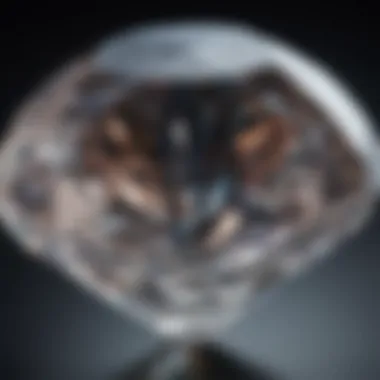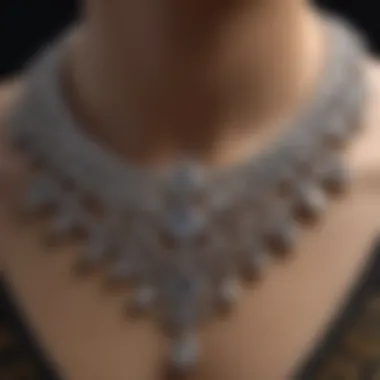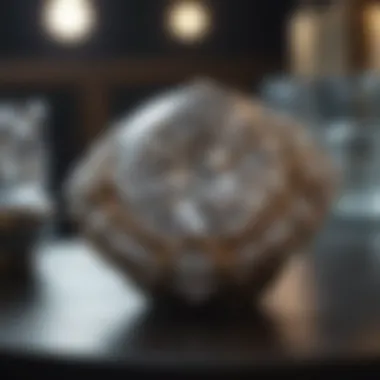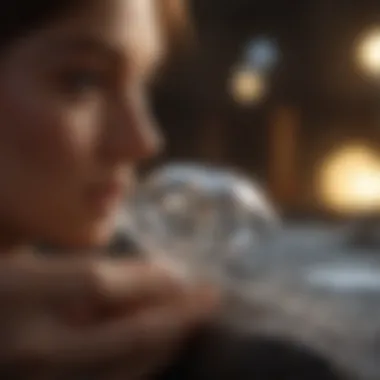The Pinnacle of Elegance: Discovering Top Diamonds


Intro
Diamonds are often revered as the ultimate symbols of luxury and elegance. They captivate collectors, jewelry designers, and gemstone enthusiasts alike, presenting a unique blend of beauty and rarity. Understanding diamonds requires more than just a cursory glance; it necessitates knowledge of their characteristics, historical significance, and the intricate processes through which they are valued. This article delves into the esteemed diamonds recognized worldwide, guiding readers through their distinct traits and the factors that shape their allure in today’s luxury market.
Gemstone Overview
Definition and Characteristics
Diamonds are crystalline forms of carbon. Their unparalleled hardness and exceptional ability to refract light make them stand out among gemstones. Unlike other stones, diamonds exhibit brilliance that can create stunning sparkle when cut properly. The four essential characteristics that define their quality are known as the Four Cs: Carat, Cut, Color, and Clarity.
- Carat refers to the weight of the diamond. Higher carat weights usually correspond with larger stones, but rarity can sometimes trump weight in valuation.
- Cut is critical to a diamond's sparkle. A well-cut diamond allows light to reflect internally and exit at optimal angles, maximizing brilliance.
- Color measures how colorless a diamond is. The most valued diamonds are those with minimal color, often assessed on a scale ranging from D (colorless) to Z (light yellow).
- Clarity gauges the internal imperfections or inclusions. Flawless diamonds are extremely rare, and small blemishes can impact the value significantly.
Classification of Gemstones
Diamonds are categorized as precious gemstones, distinct from semi-precious ones. Their classification is primarily due to their rarity and the specific allure they provide. In addition to diamonds, other well-known precious gemstones include emeralds, rubies, and sapphires. These stones each have unique characteristics, but what sets diamonds apart is their unrivaled hardness—measured as a 10 on the Mohs scale of mineral hardness.
"Diamonds are not only remarkable for their physical properties but also for their rich narratives woven throughout history."
Historical Significance
Ancient Uses and Cultural Importance
Diamonds have a long and storied history, dating back thousands of years. Originally, they were not valued as gemstones but were appreciated for their physical properties in ancient cultures. For example, they were used in weaponry, believed to offer protection and victory in battle. In ancient Indian texts, diamonds held sacred place, often seen as earthly representations of the divine.
As time progressed, diamonds transitioned from artifacts of war to symbols of power and wealth. Royalty and aristocrats adorned themselves with diamonds, signaling their status and opulence. Each diamond often carried with it tales of conquests, alliances, and tragedies that shaped the course of human history.
Myths and Legends Surrounding Gemstones
Throughout the ages, various myths and legends have emerged, attributing mystical properties to diamonds. Some cultures believed that diamonds could ward off evil spirits or bring good fortune to their wearers. Others thought they held healing properties or could enhance romantic relationships. Such narratives have only intensified the allure of these stones, adding layers of significance that go beyond material value.
The interplay between diamonds' physical beauty and their cultural implications ensures their esteemed status continues to prevail in modern society.
With this foundation, the article will further explore specific diamonds recognized for their historic and modern significance in the luxury market, shedding light on the broader implications of owning and valuing such precious gems.
Prelims to the World of Diamonds
The world of diamonds holds great fascination and allure for many. This section serves as an essential introduction, illuminating the importance of these remarkable gemstones in both contemporary and historical contexts. Diamonds are not merely beautiful stones; they represent wealth, power, and status. Their classification and significance extend beyond their appearance, crafting a narrative that reveals much about humanity's relationship with these alluring gems.
Diamonds have a unique place in various cultures and societies, often symbolizing love and commitment. Their brilliance and rarity compel people to seek them out as objects of desire. Understanding the nuances of diamonds provides a clearer picture of why so much value is placed on them. This knowledge is crucial for collectors, designers, and enthusiasts alike.
Understanding Diamond Classification
Diamond classification is a systematic approach to categorizing diamonds based on specific criteria. These criteria are often referred to as the "Four Cs": Cut, Color, Clarity, and Carat Weight. Each of these elements plays a pivotal role in determining the overall quality and value of a diamond.
- Cut: This is perhaps the most significant factor affecting a diamond's beauty. A well-cut diamond reflects light in a way that maximizes its brilliance and fire.
- Color: Diamonds come in various colors. The most valuable are those that are colorless, but there are also fancy colored diamonds such as blue and pink.
- Clarity: This refers to the presence of internal flaws or inclusions. Diamonds with fewer inclusions are more valuable.
- Carat Weight: This determines the size of the diamond. Larger diamonds are rarer and, therefore, more expensive.
Understanding these classifications helps collectors and buyers make informed decisions. Each category plays a role in the diamond's overall appeal and market value.
The Significance of Diamonds in Human History
Diamonds have captured human imagination for centuries, playing roles in both personal and political narratives. Their significance goes beyond mere adornment; they have been symbols of endurance, commitment, and wealth throughout history.
Historically, diamonds were often associated with royalty. They adorned crowns and scepters, representing power and divine right. In many cultures, diamonds also served as talismans, believed to possess protective qualities.
Furthermore, the historical trade of diamonds has influenced societies. Events around diamonds often reflect broader views on competition, power, and exploitation. The transition from royal possession to public ownership signifies the evolving nature of these stones' significance. Today, while the allure of diamonds persists, there remains a growing awareness of ethical considerations surrounding their acquisition.
"Diamonds are not just stones; they are a representation of human creativity and desire, embodying a rich tapestry of history and meaning."


In summary, diamonds have a rich and complex history. Understanding their classification and significance provides insight into their enduring allure and importance in our lives. This foundation prepares the reader for a deeper exploration of notable diamonds in history in the following sections.
Criteria for Evaluating Top Diamonds
Understanding how to evaluate diamonds is essential for anyone investing in or collecting these precious stones. The criteria used to assess diamonds serve not only to distinguish quality but also to guide buyers in making informed decisions. This evaluation can influence both the market demand and the individual valuation of diamonds, making this topic crucial to the larger discussion of diamond prestige.
The Four Cs Explained
Diamonds are evaluated based on a standardized set of criteria known as the Four Cs: Cut, Color, Clarity, and Carat Weight. Each element plays a vital role in determining the overall quality and value of a diamond.
Cut
The cut of a diamond greatly affects its brilliance and overall appearance. This term refers to how well the diamond has been shaped and faceted. A well-cut diamond reflects and refracts light effectively, resulting in a mesmerizing sparkle. A good cut can amplify the stone's beauty, making it a popular choice among collectors.
Key characteristics of cut include:
- Quality of workmanship: This impacts light performance.
- Proportions: These can enhance or detract from the diamond's appeal.
While a superb cut can elevate a diamond, poor cutting can diminish its brilliance. Thus, examining the cut is fundamental in this article.
Color
The color of a diamond ranges from colorless to light yellow or brown. A colorless diamond is often the most sought after, as it allows maximum light reflection. When evaluating this factor, the grading scale typically used observes subtle shades that influence desirability.
The absence of color is a key characteristic, proving beneficial for those prioritizing hue during diamond selection. However, certain fancy colors like pink or blue increase rarity and can fetch exceptional prices.
Each color grade can impact a diamond's value significantly.
Clarity
Clarity addresses the presence of internal or external flaws, known as inclusions and blemishes, respectively. A diamond with high clarity has few or no imperfections visible under 10x magnification. This aspect directly influences perceived quality, making clarity essential when discussing top diamonds.
The presence of unique clarity features can also illustrate a diamond's character, even if it may lower its value. Thus, understanding clarity provides insight into why certain diamonds attract higher premiums than others.
Carat Weight
Carat Weight measures the size of the diamond. One carat is equivalent to 200 milligrams. As with the other Cs, larger stones are generally more valuable. However, this metric does not stand alone in valuation. A well-cut smaller diamond may outperform a larger, poorly cut one in terms of perceived beauty.
Key details about carat weight include:
- Size perception: Large carat weights attract attention but the overall appeal is influenced by cut and clarity.
- Market trends: The demand for larger stones can lead to fluctuating prices.
Understanding these factors is essential when investing or appreciating diamonds. Each criterion influences not only the physical presence of the diamond but also its market value in various contexts.
Market Demand and Rarity
Market demand triangles with rarity in determining the value of diamonds. Beautiful stones often become coveted, resulting in competitive pricing. The interplay between collector interest and availability shapes market trends. Awareness of this dynamic allows informed decisions for buyers. As fancy and rare diamonds become increasingly sought after, a comprehensive understanding of both demand and rarity is crucial for those navigating the luxury diamond market.
Notable Diamonds in Recorded History
The examination of notable diamonds in recorded history offers insight not just into the gems themselves but also into the cultures and eras that valued them. Each diamond carries with it tales of power, allure, and sometimes controversy. The importance of these diamonds lies in their ability to reveal societal trends as well as the evolving notions of beauty and wealth. Collectors and enthusiasts alike draw inspiration from these stories, and understanding them enhances the appreciation of diamonds in a modern context.
The Hope Diamond
Origin and History
The Hope Diamond, with its rich blue hue, traces its origins back to India, where it was extracted from the Golconda mines. The diamond was originally known as the "Blue Diamond of the Crown" and is most linked to a series of royal owners before becoming a part of the American gemstone history. Its curse, which supposedly brings misfortune to its owners, adds to its notoriety, making it an attractive subject for those captivated by both beauty and intrigue. Its historical journeys through various empires exemplify how diamonds serve not merely as adornments but also as symbols of power and status.


Current Ownership and Exhibitions
Today, the Hope Diamond resides within the Smithsonian Institution in Washington D.C. It is prominently displayed, drawing millions of visitors each year. This current ownership ensures its protection while also allowing the public to marvel at its beauty. The diamond's presence in a public institution represents an evolution in how luxury items are viewed and shared with society. Its exhibitions often include educational aspects about its history, greatly benefiting the community by cultivating a deeper understanding of diamond values and the stories behind them.
The Cullinan Diamond
Cutter Expertise
The Cullinan Diamond is famed for its sheer size, weighing over three thousand carats when discovered. Its cutting was a monumental task, requiring an expert team led by Joseph Asscher. The precision involved in transforming such a massive rough diamond into cut stones, including the Great Star of Africa, highlights the mastery of gem-cutting. The expertise shown during this process has established benchmarks for quality in the diamond industry. Such historical craftsmanship underscores the levels of skill required to elevate a diamond from raw material to sought-after gem.
Historical Significance
Historically, the Cullinan Diamond bears witness to the tumultuous interplay of power and wealth during the British Empire. Its gifting to King Edward VII was symbolic, marking a significant moment in the era's imperialist expansion. This diamond serves as a reminder of colonially driven cultures where precious resources were sought after, often at a cost. Understanding its historical significance enriches one’s comprehension of diamonds not just as items of luxury but also as artifacts of human history.
The Koh-i-Noor Diamond
Political Influence
The Koh-i-Noor diamond has been linked with various rulers and empires for centuries. It has changed hands among leaders, symbolizing political power and territorial dominance. In modern times, it is a part of the British Crown Jewels, representing both historical royalty and political legacy. Discussions around its ownership raise important questions about colonial history and the ethics of ownership, highlighting the connections between diamonds and international politics.
Cultural Impact
Culturally, the Koh-i-Noor has influenced art, literature, and even nationalism. It has been used as a symbol in various narratives, reflective of the broader cultural dialogues of its time. It remains a powerful icon in both India and Britain, causing discussions regarding heritage and ownership. Understanding its cultural impact allows for a greater appreciation not just of the diamond itself but of its role in shaping collective identities.
Modern Masterpieces: Contemporary Diamonds
Contemporary diamonds represent a significant evolution in the diamond industry. They embody not just natural beauty but also meet novel aesthetic demands and cater to modern sensibilities. These diamonds capture the intersection of traditional value with contemporary design. They appeal to both a new generation of collectors and established connoisseurs who appreciate rare attributes. With social consciousness also rising, many jewel enthusiasts consider the impact of their acquisitions. Thus, discussions around contemporary diamonds frequently involve ethical sourcing and innovative practices within the diamond trade.
The Pink Star Diamond
Auction Records
The Pink Star Diamond achieved remarkable recognition via auction for several reasons. Its transformation into a star piece occurred not just because of its hue but also due to the ultimate price it garnered. Sold for $71.2 million in 2017, this diamond first made headlines due to its record-setting price at the Sotheby's Hong Kong auction.
The unique characteristic of the Pink Star's auction was its comprehensive publicity, emphasizing the growing demand for colored diamonds. This auction reinforces the idea that strong market interest can influence valuation in substantial ways. Its beneficial aspect lies in showcasing a willingness among wealthy collectors to invest heavily in exceptional gems. The substantial, high-profile media coverage surrounding the auction had the advantage of elevating the global profile of diamonds as viable luxury investment assets.
Valuation Insights
The Pink Star provides valuable insights into how valuations are conducted in the diamond market today. Valuation is often influenced by factors such as rarity, color intensity, and clarity. The key feature of the Pink Star’s valuation is its perfect color grade. Graded Fancy Vivid Pink by the Gemological Institute of America (GIA), it exemplifies how rarity directly correlates with value in the luxury market.
Consequently, the lessons learned from the valuation of the Pink Star demonstrate its dual role: as both an artistic expression and a financial asset. One advantage of understanding these insights is that they guide potential investors in determining factors that may lead to increasing values in the future. However, this somewhat speculative nature can also lead to disadvantages for those uninformed about market trends.
The Blue Moon Diamond
Unique Characteristics
The Blue Moon Diamond fascinates with its fascinating blend of rarity and unique shades. Weighing 12.03 carats, this diamond exhibits exceptional clarity and a striking hue. The key characteristic of the Blue Moon is its ability to shift perception based on the ambient light. This dynamic quality captures the attention of gemstone enthusiasts and portrays the significance of the blue color in status and value.
Its uniqueness helps underscore the modern trend towards appreciating extraordinary gems for both aesthetic and intrinsic value. In this regard, its beauty provides an excellent case study in how certain diamonds acquire contemporary relevance.
Current Owners
The current ownership of the Blue Moon Diamond adds further layers to its narrative. Bought by Lawrence Graff in 2015 for $48.4 million, it underwent an immediate public spotlight as Graff’s company, Graff Diamonds, is renowned for luxury jewels. The notable aspect of its ownership lies in how it enhances the credibility and allure of the diamond within the luxury retail sector.
Not only does this set the context for its high valuation, but it also shows how ownership ties into brand identity. While Graff's acquisition illustrates the prestige associated with top diamonds, it can also lead to disadvantages regarding exclusivity. For potential buyers, it highlights the difficulty of accessing these treasures, driving their allure even further.
"The world of diamonds continues to capture the imagination, presenting both challenges and opportunities that expand the boundaries of luxury and ethics in acquisition."


Contemporary diamonds such as the Pink Star and the Blue Moon serve as critical case studies for understanding modern diamond valuation frameworks. They illustrate how factors such as auction records and current ownership contribute to their allure and questions concerning ethical acquisition in the luxury market.
Ethical Considerations in Diamond Acquisition
Ethical considerations in diamond acquisition have grown in significance over the past few decades. The rise of consumer awareness regarding the origins of diamonds has fueled demand for ethically sourced gems. This topic plays a vital role in our understanding of the diamond industry. It encourages transparency, promotes responsible sourcing, and ultimately impacts the market dynamics of luxury diamonds.
Understanding the ethical implications involves examining both the societal and environmental factors associated with diamond mining. Buyers increasingly favor diamonds that uphold strict ethical standards. By prioritizing these considerations, the demand shifts away from dubious sources and favors sustainable practices. Ethical diamond acquisition also influences the valuation of these gems. Diamonds sourced from conflict-free areas often achieve better prices, reflecting their desirability.
Blood Diamonds and Their Impact
Blood diamonds, also known as conflict diamonds, present a significant problem in the diamond market. These stones originate from war zones and are often mined under brutal conditions. The profits from these diamonds frequently fund violence, civil wars, and human rights abuses.
The impact of blood diamonds can be far-reaching. They tarnish the reputation of the entire industry and create a trust deficit among consumers. Many people are now unwilling to purchase diamonds without assurance of ethical sourcing.
In response to this situation, organizations like the Kimberley Process Certification Scheme emerged to prevent the trade of blood diamonds. While it aims to provide a system of checks and balances, enforcement remains challenging. Therefore, it's critical for consumers to educate themselves about the origins of the diamonds they buy.
"Consumer awareness and activism can drive change in diamond mining practices and promote greater accountability."
Sustainability in the Diamond Industry
Sustainability in the diamond industry refers to practices that meet present needs without compromising future generations' ability to meet theirs. Environmental and social sustainability is increasingly viewed as essential. This means assessing the impact of mining operations on local ecosystems and communities.
Sustainable practices include:
- Responsible mining techniques: These minimize environmental degradation.
- Restoration efforts: After mining, companies become responsible for restoring ecosystems.
- Fair labor practices: Ensuring miners receive fair wages and work in safe conditions.
Many consumers now seek out lab-grown or ethically sourced diamonds, contributing to a shift in market dynamics. This shift is reflected in the rise of companies emphasizing sustainability in their sourcing methods. Brands that adopt sustainable practices can enhance their reputation, appealing to a more conscious consumer base.
By focusing on ethical considerations, the diamond industry can pave the way for a more sustainable future. Engaging with these elements is not only responsible but can also open new avenues for business and investment.
Investment Value of Top Diamonds
The investment value of top diamonds extends beyond mere aesthetics; it encompasses a blend of market trends, rarity, and emotional significance. Investing in diamonds can be viewed as a hedge against traditional financial markets, with a potential for wealth preservation. Unlike stocks or bonds, they do not fluctuate daily, making them an appealing option for certain investors. Moreover, the intrinsic value of these gems often appreciates over time, driven by demand from collectors and investors alike.
Market Trends Analysis
Market trends play a crucial role in assessing the investment potential of diamonds. In recent years, there has been a noticeable shift in consumer preferences toward colored diamonds, especially pink and blue hues. This demand surge correlates with the limited supply of these unique stones. As a result, their values are not just increasing; they are soaring to record heights. Additionally, global economic factors affect the diamond market—strong economic growth often leads to higher consumer spending on luxury goods.
"The rarity of the stone, combined with the consumer's desire for unique pieces, makes certain diamonds an excellent investment opportunity."
Trends in responsible sourcing have also influenced the market. Investors are becoming more aware of ethical implications tied to diamond mining, leading to an increase in demand for certified diamonds sourced sustainably. This shift could affect valuation as ethical provenance often commands a premium.
Factors Affecting Valuation
Market Fluctuations
Market fluctuations refer to the dynamic changes in diamond pricing due to various economic conditions. These fluctuations can be prompted by changes in the global economy, shifts in consumer purchasing behavior, and wider financial market trends. One key characteristic of market fluctuations is their unpredictability. They may benefit long-term investors who can weather short-term volatility; however, they also pose risks for those seeking quick returns.
Consumer Preferences
Consumer preferences significantly impact the value of diamonds. Preferences can span from classic clear diamonds to fancy colors, affecting which diamonds gain favor in the market. The unique feature of consumer preferences is their ability to shift based on cultural trends and major societal changes. This fluidity can create opportunities for potential investments but also carry the disadvantage of rapid depreciation for less desirable stones.
End: The Enduring Allure of Diamonds
In the complex landscape of luxury goods, diamonds maintain an unmatched allure. This appeal stems not only from their physical beauty but also from rich historical and cultural significance. Throughout this article, we have explored the factors that contribute to the status of diamonds as symbols of wealth and love. Their unique properties, such as rarity and durability, combined with fascinating stories behind notable examples, enhance their value in the eyes of collectors and enthusiasts.
The future of diamonds is currently being shaped by evolving market trends and changing consumer preferences. This transition reflects a greater emphasis on ethical sourcing and sustainability. As consumers become more informed, their choices are influenced by the narratives of how and where these diamonds are mined. This shift signifies a potential transformation in valuation methods, with ethical considerations becoming as important as traditional metrics.
Diamonds are not just objects of beauty; they are intertwined with human stories, emotions, and values.
As we look forward, advancements in technology and blockchain could offer new methods for tracking the provenance of diamonds. This ensures greater transparency in trade, boosting consumer confidence. Evaluation will likely evolve, considering more than just the Four Cs.
The timeless appeal of diamonds continues to captivate jewelry designers and collectors alike. The unique traits of each stone, including color saturation and clarity, alongside factors such as historical backgrounds, will always dictate their desirability. As the luxury market evolves, understanding these facets will be essential for anyone engaged in diamond valuation or trade.







